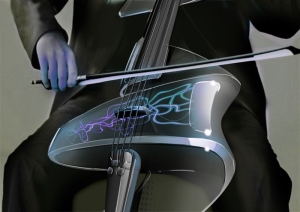Tags
aliphatic polyurethanes, Bayer MaterialScience, blank canvas, cello, Cello 2.0, coating, color, Düsseldorf, electric cello, ergonomics, fingerboard, integrated technology, intonation, K 2013, LED, light-emitting diode, lighting effects, metronome, neck, optical effects, piano, polycarbonate, polymer, polyurethane, projector, resin, saxophone, video, violoncello

Cello 2.0
A design innovation recently displayed at K 2013, the world’s largest plastics trade show in Düsseldorf, Germany, is a prototype for a cello that only remotely recalls the classic lines of the seventeenth-century violoncello.
The German polymer giant Bayer MaterialScience has fashioned the futuristic instrument from transparent, lightweight cast resin. The company’s aim was to encourage aspiring musicians to take up the cello by making what is normally a rather cumbersome instrument easier to play and carry and to entice accomplished musicians by creating a cello body that acts as a blank canvas for a range of optical effects using integrated technology.
Bayer MaterialScience assembled a team of designers and lighting specialists to create the ergonomic cello, canvassing both professional and amateur musicians for clues on how to innovate. They found that music students wanted color signals to let them know when they were out of tune or to flash like a metronome to help them keep time; professionals mused about incorporating lighting effects and video into live performances.
The design starts with a more-or-less standard electric cello neck and fingerboard into which sound and optical technology is built, from LED lighting to mini video projectors that can display photos, graphics or video on the transparent surface of the cello. The slimmed-down cello belly is then formed from a lightweight material based on aliphatic polyurethanes.
The company imagines applying the technology used to make Cello 2.0 to the future design of keyboard, plucked and wind instruments. It has already helped build break-resistant saxophones made from a colored polycarbonate blend, as well as high-gloss polyurethane piano coatings.
– Bayer MaterialScience

The cello is cool… but the Vibratosax (see link @ http://www.vibratosax.com/products.php?id=1) is absolutely wonderful!